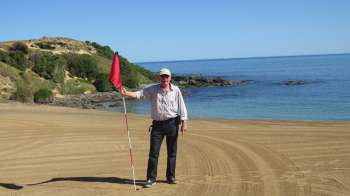The Pitfalls of Redesign
In 2004 I set off to research and write Planet Golf, a book on the greatest golf courses outside America. The publication took three years to complete and involved travel to more than 600 golf courses in 43 countries, the need to be thorough born out of my desire to learn as much about design and uncover as many hidden gems as possible. Following its release in 2007, I spent six months in the USA studying 250 of the best American courses, including 99 from the Top 100, for Planet Golf USA. While I was fortunate to be able to play some incredible golf courses, the truth is that most of the golf I saw overseas was disappointing.
Since completing Planet Golf USA I have established an architectural consultancy business called the Global Golf Group, which aims to work with developers and existing golf clubs to help identify and select the most suitable course designers for their project. This crucial design appointment can be the making of a golf club, yet often the decision is made on reputation, or because of cost or existing relationships. Considering the expense involved in large-scale redesign programs, it’s vital that clubs go through a thorough and meaningful selection process before making any architectural appointment. Relying on ranking lists, brochures or word of mouth can be a recipe for disaster.
Beyond visiting 850 odd courses, I also saw the work of more than 130 active golf designers, which means I’m able to critique and compare the strengths and weaknesses of most candidates short-listed for work. There are several designers that my consultancy business has ‘Quality Endorsed’, but I subscribe to the view that every golf course is unique and there aren’t any architects that are suitable for every project. The most appropriate architect depends as much on the ambition of the client as it does on budget, site, design concepts and experience.
Before a board or greens committee decide to redesign or revitalize their layout, it’s important they can communicate to the membership why the changes are necessary, and also that they also have a clear understanding of what can be achieved through such a program. Often I sense that clubs aren’t ambitious enough when it comes to redesign work, they might feel their course is tired or dated and subsequently focus more on freshening up its appearance than on exploring ways to extract great golf out of their terrain. Sadly, a poor hole stretched an extra 50 yards is usually still a poor hole.
It’s important to be realistic, however, and there is no point employing a designer who claims to be able to elevate your course into the Top 10 if that isn’t a realistic achievement. Great golf is as much about great land as great design, and if you don’t have natural features, sandy soil or an interesting canvas then there are limits to how good your course can be.
So accepting that appointing an appropriate designer is the first step to a successful course redesign, there are several factors to consider before determining who should carry out any work at your club. Aside from assessing the quality of the candidates, you also need a clear idea of the scope and nature of any intended work as well as an accurate understanding of what the club can afford. Some architect’s work better on inferior ground than others, some can handle big budget projects more ably while others are expert at working with natural and undulating terrain.
Because each project is different, it’s crucial that clubs match the ability and philosophy of their chosen golf designer with the particular needs and ambition of their membership. Ideally board members will have spent time visiting the architect’s best and worst work in order to get a sense of their capabilities. If this is not possible then they should consider hiring an independent expert to prepare a short-list of design candidates and provide feedback on the suitability of each architect as well as an idea of what can reasonably be achieved through redesign or restoration. If the decision makers don’t understand the craft of golf course design, or haven’t experienced a wide range of sample work, then the role of the independent consultant becomes even more important.
Aside from selecting the wrong architect for the property, the other common mistake made by clubs embarking on major works is to focus too much on making holes longer and harder. Unless you are a legitimate championship venue, and feel the need to protect an established reputation, sacrificing good holes for difficult ones is extremely shortsighted as the benefits of a stronger golf course are diminished if the layout loses charm and appeal through the process. The truth is the average golfer finds the average golf course hard enough. If handled poorly, therefore, stretching holes can diminish the overall appeal of your layout for the vast majority who play it.
The interesting thing about golf consultancy and, more specifically, my travels abroad, is that people assume layouts like Cypress Point, Pine Valley, Sand Hills, St Andrews and National Golf Links taught me the most about design, but in fact you actually learn more about golf from poor work than great work. You learn about limitations, both of an architect’s ability and of restrictions with the land. Equally, bad golf helps delineate great design and teaches you how to identify areas of improvement. This is especially true of older golf courses in decline or those that have been neglected over the years.
I’ve been fortunate to see almost all of the world’s best courses, and am equally thankful for the opportunities I had to sample poor and over-rated golf. As a course consultant my objective is to raise golfing standards and to ensure that clients are aware of the true potential on their land, and also the ability of the architects on their short list. Deciding who should be in charge of altering your most valuable asset is a major decision for any golf club. Making an informed judgment based on relevant factors is absolutely critical, and is where my passion for great golf architecture and experience at the world’s finest courses can be of value. I urge any club looking to make significant changes to ask themselves whether there is sufficient knowledge and understanding of design to make this decision internally. If not please contact the Global Golf Group for frank and independent advice on how to maximize the golfing potential of your property.
Back to NewsMore News
Who Really Designed Cape Wickham Links?
AGD ranks Cape Wickham #1 in Australia & interviews Duncan Andrews to get full story on course design
Landmark professional golf tournament coming to Auckland
Pro golf will make a major return to NZ's largest city next March with event hosted by Royal Auckland & Grange
Grace Kim confirmed for 2026 women's Australian Open
Australian star will headline the Women’s Open when it returns to Kooyonga Golf Course in March
AGF releases 2024/25 Impact Report, highlighting life-changing opportunities for young Australians
The Australian Golf Foundation Report reveals a year of progress in making golf more accessible, inclusive, and life-changing for young people



